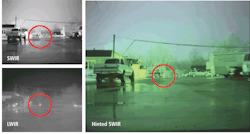IMAGE FUSION: Hinted SWIR fuses LWIR and SWIR images for improved target identification
Image fusion is a process of combining video streams from multiple sensors into a single composite video stream in real time without losing contrast or resolution. Because no single sensor modality works perfectly in all scene variations, "Hinted SWIR" from Goodrich ISR Systems (Princeton, NJ) combines complementary features of multiple sensing modalities through image fusion.
The best of both worlds
Shortwave-infrared (SWIR) light bridges the spectral gap between the visible and thermal bands, detecting reflected light and propagating longer distances undistorted and scatter-free than shorter-wavelength visible light, making it better suited for imaging through fog, dust, and smoke. In addition, SWIR imagers excel in low-light conditions and use 1550 nm eye-safe illumination that is undetectable by regular night-vision technologies. Most importantly, indium gallium arsenide (InGaAs) SWIR imagers can see all lasers on the battlefield with high dynamic range—a capability lacking in image-intensified night-vision equipment.
Longwave-infrared (LWIR) imagers, on the other hand, see thermal emissions, making them excellent for detecting hot targets such as people or vehicles. Although thermal imagers can sometimes provide better obscuration penetration than SWIR, dawn and dusk transitions and capturing shadows and contrast in reflected light are challenging. As a result, SWIR imagery offers an essential complement to thermal imagery for positive target identification.
Hinted SWIR, a Goodrich-trademarked variant of image fusion, works particularly well in cold, wet, overcast urban night scenes where important low-light-level illuminated scene detail from the SWIR sensor forms a contextual background for thermally active target highlights detected with the LWIR sensor (see figure).
Fusing images
In a Hinted SWIR video stream, the operator does not have to switch focus between separate sensor displays; features rendered differently by the individual sensor modalities stand out clearly in a single co-registered display. Image fusion is achieved by taking the 12-bit grayscale CameraLink digital output of a 640 × 512 pixel format SWIR and the digital output of a 320 × 240 pixel format LWIR camera and combining them in real time and at full frame rate (30 fps) on a frame-by-frame basis after a linear scale and offset transformation and colorization of the LWIR data. The scene temperature registered in the LWIR pixel data is encoded in a false-color spectrum with red representing hot and and blue representing cold. The intensity and transparency of the color encoding is a fully adjustable parameter of the field-programmable-gate-array-based fusion algorithm.
"Hinted SWIR uses the 90 g, extremely high-quantum-efficiency InGaAs SU640KTSX imager, capable of full-motion video at 640 × 512 pixel resolution from daylight to quarter-moon with uncooled operation," says David G. Dawes, manager of business development for DoD applications at Sensors Unlimited (part of Goodrich). "And because it requires only 2.5 W of electrical power and spectral-response ranges from 0.7 to 1.7 µm, encompassing all key battlefield-laser wavelengths, Hinted SWIR is targeted at small unmanned aerial systems payload and man-portable sensor applications."

Gail Overton | Senior Editor (2004-2020)
Gail has more than 30 years of engineering, marketing, product management, and editorial experience in the photonics and optical communications industry. Before joining the staff at Laser Focus World in 2004, she held many product management and product marketing roles in the fiber-optics industry, most notably at Hughes (El Segundo, CA), GTE Labs (Waltham, MA), Corning (Corning, NY), Photon Kinetics (Beaverton, OR), and Newport Corporation (Irvine, CA). During her marketing career, Gail published articles in WDM Solutions and Sensors magazine and traveled internationally to conduct product and sales training. Gail received her BS degree in physics, with an emphasis in optics, from San Diego State University in San Diego, CA in May 1986.
